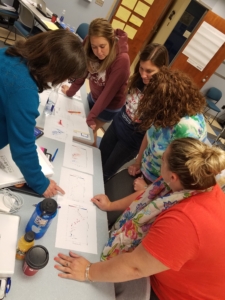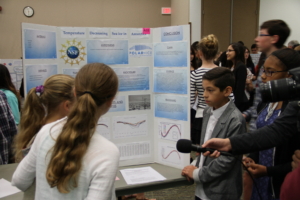Polar Science Investigations (Sci-I) Project

Some of the Polar-ICE Sci-I Project 2016 participating teachers (left to right): Tom Grych, Jennifer Smolyn, Dolores Taylor, Carolyn Laymon, Kimberly Kellam, Kelly Terry, Denise Hardoy, Sue Morrow, Stacia Lothian; and Dr. Bridgette Clarkston (co-facilitator, California State University, Monterey Bay) touring the RU COOL lab.
The Polar ICE Science Investigations (Sci-I) Project was designed to increase skills in designing and conducting open-ended science investigations as well as analyzing and interpreting online data in alignment with Next Generation Science Standards (NGSS) through the lens of polar science for both educators and students.
The Sci-I Project focused on students in grades 6-9 and on broadening participation in STEM. The project, which was active from 2015-2018, focused on partnering with school districts that served communities predominately underserved in STEM.
If you would like to recreate the Sci-I program in your school, we encourage you to check out our Sci-I Project Development & Implementation Guide.
The Student Polar Research Symposium was the culminating event of the Sci-I Project designed to facilitate student exchange of ideas and findings about the Polar Regions. Students were empowered as science communicators and peer educators through a scientific poster session and panel discussion with Polar scientists. For more, check out our video documentary.
Components of the Sci-I Project

1) Professional Development for Educators (Summer)Participating educators explored polar science, real world data, and the process of developing an open-ended science investigation during the summer workshop. Educators interacted over a four day Professional development program with polar scientists and engaged in open-ended science investigations to learn themselves and to explore how to effectively lead students in designing, developing, and conducting polar science investigations. Two educators from each school worked together to co-develop their plan for the school year. See Chapter 3 Summer Educator Workshop in the guide for more information and resources that we used. |
2) Student Investigations (Fall)
During the year, students conducted their own open-ended, student-developed investigations using authentic, real world, online polar data. Students were empowered to develop testable questions and an inquiry-based scientific investigation that built upon their knowledge of the process of science. Students developed scientific posters to communicate their results. Students learned:
Students also learned about the importance of communicating their science to their peers in preparation for the student polar science research symposium. See Chapter 5 Mini-Proposals in the guide for more information and resources and student activities that we shared with teachers. |
3) Polar Student Research Symposium (Spring)
Scientists travel to professional conferences to present their research to peers, so should students! Each year, students participating in the Sci-I project presented the results of their open-ended science, using online real world polar data, investigations to polar scientists and one another. The top groups from each Sci-I Project school presented their science posters at the SPRS Poster Session. Members of the presenting group rotated through presenting on their investigation and observing other students’ investigations. Similar to a real professional conference, at least one participating scientist, educator, and a group of students were assigned to review each poster. The agenda was developed to ensure that each reviewer would be able to spend roughly 10 minutes at each poster they were reviewing. Sample Agenda for a SPRS: Sci-I Poster Guidance
See Chapter 6 Student Research Symposium in the guide for more information and resources that we used during the events. |
Previous Student Polar Research Symposiums
- Cohort 2016-17
- February 24, 2017: California State University – Monterey Bay, Seaside, CA
- June 8, 2017: Rutgers University, New Brunswick, NJ
- Cohort 2017-18
- March 1, 2018: Washington University in St. Louis, St. Louis, MO
- March 8, 2018: The Ohio State University, Columbus, OH
- March 15, 2018: California State University – Monterey Bay, Seaside, CA
- June 5, 2018: Rutgers University, New Brunswick, NJ



